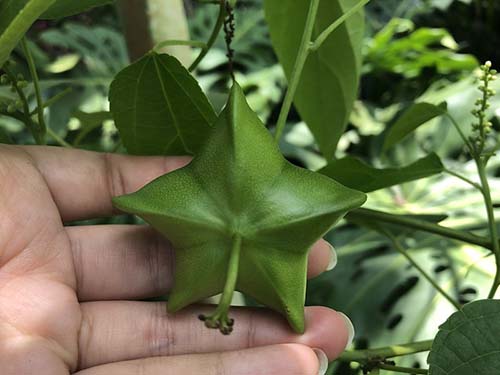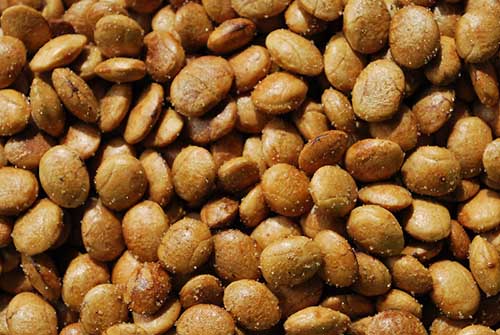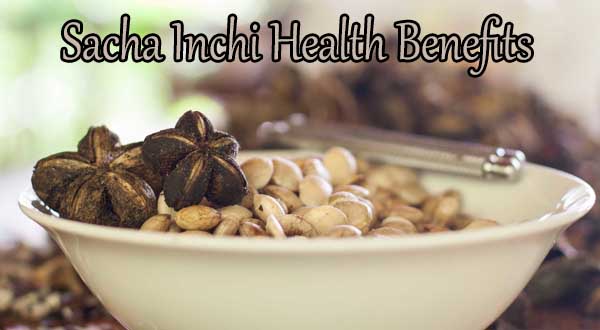By far one of the coolest looking seeds, sacha inchi is getting a lot of attention as a superfood for weight loss, skin, hair, heart health and numerous other benefits. Here’s what you need to know about the superfood seed and which health benefits are really backed by evidence.
What Is Sacha Inchi?

Sacha inchi is a tree which produces star-shaped fruits. The fruit contains 4-7 oval seeds. After falling off the tree, the fruit dries and the pods open up and the seeds fall out. The seeds need to be roasted before eating or they can be pressed into oil
Even though sacha inchi has been eaten by indigenous South Americans for centuries, it has only recently become well-known around the world because of its “superfood” status and health benefits.
Where Does Sacha Inchi Grow?
Sacha inchi is native to Peru but also grows in some other tropical parts of South America (including Ecuador, Columbia, Bolivia, Brazil and Venezuela). It was introduced to China in 2006 and now grows there as well as in several Southeast Asian countries, such as Thailand.
Why Is Sacha Inchi a Superfood?
Sacha inchi is best known for its very high levels of healthy fats. Approximately 50% of the seed is oil, of which half is Omega 3 linolenic acid. Thus, it is considered one of the best sources of omega-3 and is a great alternative to fish oil and flaxseed oil.
While the omega-3 content of sachi inchi gets most attention, the seed also has high amounts of protein, minerals and iodine. New scientific research also shows that antioxidants and other nutrients in sacha inchi may have wide-reaching benefits for weight loss, mental health, cardiovascular health, fighting inflammation, skin and hair, and other health benefits.
Recommended Products:
Amazon Therapeutics Organic, Cold-Pressed Sacha Inchi Oil

MRM Organic 100% Sacha Inchi Protein Powder
What Does Sacha Inchi Taste Like?
Roasted sacha inchi is crunchy like an almond. It also has a nutty and slightly woody aftertaste. Some people say that there is a faint fishy aftertaste as well. As with all seeds and oils, heat and light will cause sacha inchi to go rancid and get an unpleasant taste, so be sure to store it in a cool place for best taste.
Other Names for Sacha Inchi
- Plukenetia volubilis (Latin)
- Inca nut
- Inca Peanut
- Sacha Peanut
- Mountain Peanut
Health Benefits of Sacha Inchi

Most of the health benefits of sacha inchi are attributed to its omega 3 content. However, the seed also contains numerous other compounds which can provide health benefits. Recently there has been a lot of research into these benefits. The top benefits supported by science are listed below.
1. Weight Loss
Sacha inchi is considered a weight loss superfood because of its high levels of omega 3 fatty acids. These help suppress appetite as well as adipogenesis, or the formation of fat cells. There is also some evidence that omega 3 fatty acids increase metabolism, build muscle, and increase the benefits from exercise. It also helps weight loss because it contains the amino acid tryptophan which helps regulate appetite. (1, 2)
2. Cardiovascular Health and Reducing Cholesterol
Various studies have found that sacha inchi is effective at reducing levels of LDL (“bad”) cholesterol while increasing levels of HDL (“good”) cholesterol. In one study, LDL levels dropped by 33% and HDL levels increased by 72% compared to the control group. It also helps cardiovascular health in numerous other ways, such as by reducing inflammation in the arteries and lowering blood pressure. (3)
3. Skin and Hair
Omega 3 fatty acids, which the body converts into eicosapentaenoic acid (EPA), and docosahexaenoic acid (DHA), are incredibly important for skin and hair. They help keep the skin hydrated and help with wound healing. The anti-inflammatory benefits reduce acne as well as skin conditions like eczema and psoriasis. As for hair benefits, there is some evidence that omega 3 can stimulate hair follicles so hair grows thicker and faster.
Because of these benefits, many beauty creams contain sacha inchi oil. Some people also apply the oil directly to their skin or hair. However, eating the seed or oil will also help your skin and hair from the inside-out. (4, 5)
4. Inflammation
We now know that inflammation is a root cause of many health conditions ranging from IBS to depression. Studies have shown that sacha inchi can reduce inflammation in the body – particularly inflammation caused by obesity or an intake of high saturated fats. In addition to this, there are many studies which show the benefits of omega 3 in reducing inflammation biomarkers. (6, 7, 8)
5. Mental Health
Sacha inchi supports mental health in numerous ways. It helps improve levels of Gamma Aminobutyric Acid (GABA) in the brain, a chemical known for its role in lowering stress, anxiety, and preventing neurons from getting overexcited. Low levels of GABA are linked to depression, anxiety, sleep disorders and other mental health issues. Animal studies have also shown that sacha inchi helps treat depression and regulate serotonin levels. (9, 10, 11, 12, 13, 14)
6. Complete Protein
Sacha inchi seeds are approximately 30% protein. When the oil is extracted to make a protein powder, it can contain upwards of 60% protein by weight. Not only is this a very high amount of protein but the seed has all 9 essential amino acids, thus making it a complete protein. It has much higher levels of amino acids than other common seeds and beans, including soybeans.
Comparison of Amino Acids in Sacha Inci Flour vs. Soy Flour (15)
| Amino acids (%) | Sacha Inchi flour | Soy flour |
| Tryptophan | 2.25 | 0.76 |
| Cystin | 1.35 | 0.79 |
| Methionine | 0.68 | 0.76 |
| Alanine | 2.04 | 2.17 |
| Arginine | 6.13 | 3.70 |
| Aspartic acid | 6.83 | 6.07 |
| Glutamic acid | 7.71 | 9.77 |
| Glycine | 6.31 | 2.19 |
| Histidine | 1.17 | 1.35 |
| Isoleucine | 2.73 | 2.38 |
| Leucine | 4.03 | 4.00 |
| Phenylalanine | 1.42 | 2.62 |
| Proline | 2.29 | 2.58 |
| Serine | 3.48 | 2.65 |
| Threonine | 2.65 | 2.09 |
| Total lysine | 2.95 | 3.27 |
| Tyrosine | 2.87 | 1.70 |
| Valine | 3.46 | 2.53 |
7. Reduces Oxidative Stress
Oxidative stress occurs when there are too many free racicals in the body and not enough antioxidants. This can lead to fatigue, inflammation, lowered immunity, headaches, and even wrinkles. Sacha inchi has been shown to decrease oxidative stress biomarkers, thus protecting the body from harm. (16)
Fish Oil vs. Sacha Inchi Oil
Fish oil is generally considered the “best” omega 3 supplement. However, because of environmental concerns and the fact that fish oil is often contaminated with toxic chemicals from water pollution, many people are moving away from fish oil. Sacha inchi is a good alternative to fish oil as it is generally sustainably sourced and even provides income for indigenous populations in South America.
Approximately 50% of sacha inchi oil is omega 3 oils. By comparison, sardine oil (which has one of the highest omega 3 content) is only 34% omega 3. However, sacha inchi oil does not contain any EPA or DHA like fish oil does. Your body can convert some omega 3 into EPA and DHA, but it is not as effective as getting these oils directly from the supplement.
Flaxseed Sacha Inchi
Flaxseed and sacha inchi contain very similar amounts of omega 3 fatty acids. However, it isn’t just omega 3 which makes these seeds superfoods. They also contain healthy compounds like amino acids, tocopherols and polyphenol antioxidants. Flaxseed has more of certain compounds whereas sacha inchi has more of others. Neither is necessarily “better” than the other: instead of trying to meet nutritional needs with just one supplement, you should eat a variety of omega-3 rich foods. (17, 18)
Is Sacha Inchi Safe to Eat?
Both sacha inchi oil and seeds are safe to eat. However, the seeds contain some phytotoxins (including saponins and alkaloids) and antinutrients. These are broken down during the roasting process, which is why eating raw sacha inchi seeds isn’t recommended. Some people do get an upset stomach or nausea when they first try sacha inchi but this goes away after a week of consumption. To minimize any bad side effects, start by taking a small amount of the supplement and then gradually increasing the amount you eat. (19)
Best Sacha Inchi Oil
Sacha inchi oil is made by pressing the seeds and collecting the oil. When buying, make sure you choose one which is cold-pressed as this helps retain the nutrients. Also look for products in dark-colored bottles as this protects against the UV rays and oxidation.
Amazon Therapeutics Organic Sacha Inchi Oil
This sacha inchi oil isn’t just organic and cold pressed but also one of the best deals. It comes in an 8.5oz bottle, which makes it cheaper per ounce than most similar products. It is 100% sacha inchi and no heat or chemicals are used in when processing it. You can apply it directly to the skin or use it on salads. The taste is light and nutty without any fishy aftertaste or odors.
Mayan’s Secret Organic Sacha Inchi Oil
Grown organically in Peru, this sacha inchi oil is also a good price. It comes in 4.5oz bottles with an eye dropper for easy measuring.
Flora Organic Sacha Inchi Oil
Also in 8.5oz bottles and a great value, this sacha inchi oil is made from cold-pressed seeds. The only problem is that they make small quantities so the oil is often out of stock.
Botanical Beauty Organic Sacha Inchi Oil
This sacha inchi oil comes in small 0.5oz bottles with an eye dropper. It isn’t the best value per ounce, but is a good option if you just want to try out sacha inchi oil to see whether you like it. The quality is great and it is sourced from the Amazon rainforest.
Best Sacha Inchi Protein Powders
When you remove the oil from sacha inchi seeds, you are left with a powder which is over 50% protein. Because it doesn’t contain as much oil as the seeds, sacha inchi protein powder is more shelf stable and generally has a better taste than the whole roasted seeds. Below are some good brands of sacha inchi protein powders.
MRM Organic 100% Sacha Inchi Protein Powder
MRM is a very reputable brand. They source their sacha inchi in Peru, where it is grown organically. It is turned into a powder there before being sent to their production facility in the USA for packaging. The entire process is controlled and the sacha inchi powder is kept at a cool temperature during storage. It has a really nice nutty flavor and isn’t fishy at all.
Imlakesh Organic Gelatinized Sacha Inchi Protein Powder
Gelatinized does not mean that this sacha inchi protein powder contains gelatin (it is completely vegan). Rather, gelatinization is a process which breaks down the starches in the seed, making it more easily digestible. The downside is that some of the nutrients might be affected by the heat. However, if you have problems digesting protein powders, this is worth trying. It is organic, vegan, Fair Trade, non-GMO and contains 10% of your iron RDA per serving. The packaging was designed with eco-friendliness in mind.
Food to Live Organic Sacha Inchi Protein Powder
This sacha inchi powder comes in various size packages, so is a good deal if you want to buy in bulk. It is grown organically in Peru and has a pleasant nutty taste. In general, it tastes better than most other brands of sacha inchi protein powder
Where to Buy Sacha Inchi Seeds
Some stores like Whole Foods and Trader Joes have started carrying sacha inchi seeds. You can also find them online. I like this brand. The taste is very similar to the fresh roasted sacha inchi seeds I ate while living in Peru, so the company is probably good about properly storing their seeds so they don’t go bad.
If you think that sacha inchi is cool, then check out these
11 Peruvian superfoods you never heard of.









